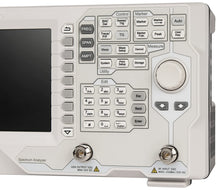
- 9 kHz to 1.5 GHz Frequency Range
- 1.5 GHz Tracking Generator (TG)
- Multiple markers and marker table functionality
- Peak table function for quicker peak signal analysis
- Trace averaging function to easily detect intermittent signals
- Typical -135 dBm Displayed Average Noise Level (DANL)
- 10 Hz Minimum Resolution Bandwidth (RBW)
- External 10 MHz Reference Input
- -80 dBc/Hz @10 kHz offset Phase Noise
- Total Amplitude Uncertainty <1.5 db
- Soft touch buttons with intuitive menu structure
- Standard with Preamplifier and AM/FM Demodulation Function
- 8 inch (800×480 pixels) high-definition display with clear, vivid, and easy to use graphical interface
- Complete connectivity with standard interfaces such as LAN, USB Host, USB Device
- Upgradeable Firmware
- Compact size, lightweight 9.4lbs
The Rigol DSA815-TG is a compact and light weight Spectrum Analyzer with premium performance for portable applications. The use of digital IF (intermediate frequency) technology guarantees reliability and performance to meet the most demanding RF applications.
The very large display (20.3 cm / 8") of the Rigol DSA815-TG Spectrum Analyzer provides a resolution of 800x480 pixels allowing a very good overview of all its comfortable functions like Auto Tune, Auto Range, Auto Scale and Auto Couple. These functions enable the analyzer to acquire signals and match parameters automatically, compared to the manual process necessary with a traditional analyzer.
The Rigol Spectrum Analyzers have a sophisticated and easy to use user interface offering multiple functions for all tasks. The menu navigation is very intuitive and all functions and parameters are easy to locate thanks to the graphical interface.
Noise floor as low as -161 dBm - Displayed Average Noise Level determines the lowest power level an analyzer can resolve. It is effected by settings including PreAmplifiers, Attenuation, and RBW. On the DSA800 Series, Typical Normalized DANL is as low as -161 dBm with the standard preamp activated on the 3.2 and 7.5 GHz models.
Down to 10Hz Minimum Resolution Bandwidth (RBW) - Provides high resolution to separate signals with similar frequencies enabling easier signal identification.
Resolution Bandwidth sets the distance between measurements in frequency. This is important, for instance, when you need to differentiate between 2 carriers that are only 50 Hz apart. They can't be viewed as distinct signals with a RBW setting as large as the separation.
| Function | Spectrum Analyzer Rigol DSA815 | |
|---|---|---|
| Channels | 1 | |
| Frequency Range | 9 kHz to 1.5 GHz | |
| Frequency Resolution | 1 Hz | |
| Internal Frequency Reference | 10 MHz | |
| Span | 0 Hz (zero Span) 100 Hz to 1.5 GHz |
|
| DANL (Displayed Average Noise level) (Normalized to 1 Hz) |
100 kHz to 1 MHz 1 MHz to 1.5 GHz |
< -110 dBm, < -130 dBm (typ.) < -130 dBm + 6 x (f / 1 GHz) dB, < -135 dBm (typ.) |
| DANL (with Preamplifier) (Displayed Average Noise level) (Normalized to 1 Hz) |
100 kHz to 1 MHz 1 MHz to 1.5 GHz |
< -130 dBm, < -150 dBm (typ.) < -150 dBm + 6 x (f / 1 GHz) dB, < -155 dBm (typ.) |
| Amplitude Range | DANL to +20 dBm | |
| Max. Input Voltage | 50 V | |
| Sweeptime Range | 100 Hz ≤ Span ≤ 1.5 GHz 0 Hz (zero Span) |
10 ms to 1500 s 20 µs to 1500 s |
| Sweepmodes | Normal or Single | |
| Resolution Bandwidth (RBW) | 10 Hz to 1 MHz (in 1-3-10 sequence) | |
| Video Bandwidth (VBW) | 1 Hz to 3 MHz (in 1-3-10 sequence) | |
| Input Impedance | 50 Ω nominal |














